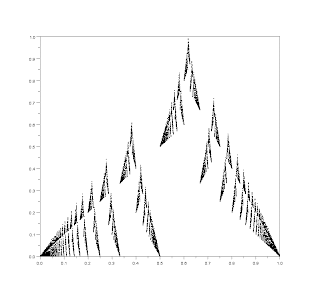This part will deal mainly with the constructive elements of a fractal class derived from the conjectured asymptotic nature of the euclidean summation.
First some basic sequences and functions:
r-golden ratio builder
[;g_0^r=r, \; g_{n+1}^r = 1 + \frac{1}{g_n^r};]
upward shifted by r identity
[;u_n^r=n+r;]
upper ratio coefficient
[;\overline{\lambda}:[0,\infty) \rightarrow (0,1], \; \overline{\lambda}(x)=\frac{1}{1+x};]
where r>0 is a real number.
Let us consider some properties of the above sequences and functions:
[;\lim_{n\rightarrow \infty}\overline{\lambda}(g_n^r) = 1-\phi, \sum_n (-1)^n \cdot \prod_{i=0}^{n} \overline{\lambda}(g_i^r) \; convergent;]
[;\lim_{n \rightarrow \infty} \overline{\lambda}(u_n^r) = 0, \prod_n (1 - \overline{\lambda}(u_n^r)) \; convergent \; to \; 0;]
For the upward shifted by r identity, the conclusions are self evident due to:
[;\overline{\lambda}(u_n^r) = \frac{1}{1+n+r};]
and
[;\prod_{i=0}^{n} (1 - \overline{\lambda}(u_n^r)) = \frac{r}{1+n+r};]
For the r-golden ratio builder, the first conclusion's proof is based upon the relative positions of r and the golden ratio.
Indeed, if r is equal to the golden ratio then the r-golden ratio builder is stationary (and equal to the golden ratio).
From the two left cases let's consider the case r is smaller than the golden ratio. With this assumption we get:
[;r^2 -r -1 < 0 \Rightarrow g_1^r - g_0^r = -\frac{r^2-r-1}{r} > 0;]
By means of mathematical induction one can prove that the subsequences of even index and odd index terms of the r-golden ratio are respectively increasing and decreasing. Since both sequences fall between the two first terms of the sequence results that they are both convergent to respectively g and h.
We get successively:
[;\left\{ \begin{array}{rcl} g & = &1+\frac{1}{h}\\ h & = &1+\frac{1}{g} \end{array} \right. \Leftrightarrow \left\{ \begin{array}{rcl} g & = &1+\frac{1}{1+\frac{1}{g}} \\ h & = & 1+\frac{1}{g} \end{array} \right. \Leftrightarrow;]
[;\left\{ \begin{array}{rcl}g & = & \frac{2\cdot g +1}{g+1} \\ h & = & 1 + \frac{1}{g}\end{array}\right. \Leftrightarrow \left\{ \begin{array}{rcl} g^2 -g -1 & = & 0\\ h & = & 1 + \frac{1}{g} \end{array} \right. \Leftrightarrow;]
[;\left\{ \begin{array}{rcl}g & = & \varphi \\ h & = & 1 + \frac{1}{g}\end{array}\right. \Leftrightarrow \left\{ \begin{array}{rcl} g & = & \varphi \\ h & = & \varphi \end{array} \right.;]
[;\left\{ \begin{array}{rcl}g & = & \frac{2\cdot g +1}{g+1} \\ h & = & 1 + \frac{1}{g}\end{array}\right. \Leftrightarrow \left\{ \begin{array}{rcl} g^2 -g -1 & = & 0\\ h & = & 1 + \frac{1}{g} \end{array} \right. \Leftrightarrow;]
[;\left\{ \begin{array}{rcl}g & = & \varphi \\ h & = & 1 + \frac{1}{g}\end{array}\right. \Leftrightarrow \left\{ \begin{array}{rcl} g & = & \varphi \\ h & = & \varphi \end{array} \right.;]
Therefore the entire sequence is convergent to the golden ratio. Since the golden ratio is not equal to 1 results that:
[;\sum_n (-1)^n \cdot \prod_{i=0}^{n} \overline{\lambda}(g_i^r);]
is convergent.
Having these sequences and functions completely described let us consider the two mechanisms we will use in order to define the previously mentioned class of fractals:
The top value base sequence
For any four complex numbers u,v,w,z shaping a trapezoid and the sequences:
[;(\alpha_n)_{n\ge 0}, \; (\beta_n)_{n\ge 0};]
defined by:
[;\alpha_0=u, \; \beta_0=v, \beta_1=w,\; \alpha_1=z;]
and
[;\left\{ \begin{array}{rcl} \alpha_{n+2} & = & (1 - \overline{\lambda}(g_n^r))\cdot \alpha_{n+1}+ \overline{\lambda}(g_n^r) \cdot \alpha_{n} \\ \beta_{n+2} & = & (1 - \overline{\lambda}(g_n^r))\cdot \alpha_{n+1}+ \overline{\lambda}(g_n^r) \cdot \beta_{n} \end{array} \right. ;]
we have that:
[;(\alpha_n)_{n\ge 0} \rightarrow \alpha;]
The self-similarity base sequence
For any four complex numbers u,v,w,z shaping a trapezoid and the sequences:
[;(\tilde{\alpha}_n)_{n\ge 0}, \; (\tilde{\beta}_n)_{n\ge 0};]
defined by:
[;\tilde{\alpha}_0=u, \; \tilde{\beta}_0=v, \tilde{\beta}_1=w,\; \tilde{\alpha}_1=z;]
and
[;\left\{ \begin{array}{rcl} \tilde{\alpha}_{n+2} & = & (1 - \overline{\lambda}(u_n^r))\cdot \tilde{\alpha}_{n+1}+ \overline{\lambda}(u_n^r) \cdot \tilde{\alpha}_{0} \\ \tilde{\beta}_{n+2} & = & (1 - \overline{\lambda}(u_n^r))\cdot \tilde{\alpha}_{n+1}+ \overline{\lambda}(u_n^r) \cdot \tilde{\beta}_{0} \end{array} \right. ;]
we have that:
[;(\tilde{\alpha}_n)_{n\ge 0} \rightarrow \tilde{\alpha}_0;]
For both sequences r is the scaling ratio of the two parallel edges of the trapezoid i.e.:
[;(u-v)=r\cdot (z-w);]
The construction of the above two sets of sequences is better depicted by the following figures:
and
Next: The euclidean fractal class



